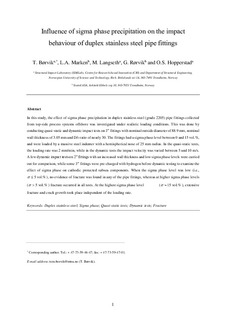| dc.contributor.author | Børvik, Tore | |
| dc.contributor.author | Marken, Lene Anita | |
| dc.contributor.author | Langseth, Magnus | |
| dc.contributor.author | Rørvik, Gisle | |
| dc.contributor.author | Hopperstad, Odd Sture | |
| dc.date.accessioned | 2017-11-02T08:20:39Z | |
| dc.date.available | 2017-11-02T08:20:39Z | |
| dc.date.created | 2014-12-12T08:35:39Z | |
| dc.date.issued | 2016 | |
| dc.identifier.citation | Ships and Offshore Structures. 2016, 11 (1), 25-37. | nb_NO |
| dc.identifier.issn | 1744-5302 | |
| dc.identifier.uri | http://hdl.handle.net/11250/2463596 | |
| dc.description.abstract | In this study, the effect of sigma-phase precipitation in duplex stainless steel (grade 2205) pipe fittings collected from top-side process systems offshore was investigated under realistic loading conditions. This was done by conducting quasi-static and dynamic impact tests on 3” fittings with a nominal outside diameter of 88.9 mm, nominal wall thickness of 3.05 mm and D/t-ratio of nearly 30. The fittings had a sigma-phase level between 0 and 15 vol.%, and were loaded by a massive steel indenter with a hemispherical nose of 25 mm radius. In the quasi-static tests, the loading rate was 2 mm/min, while in the dynamic tests the impact velocity was varied between 5 and 10 m/s. A few dynamic impact tests on 2” fittings with an increased wall thickness and low sigma-phase levels were carried out for comparison, while some 3” fittings were pre-charged with hydrogen before dynamic testing to examine the effect of sigma phase on cathodic protected subsea components. When the sigma-phase level was low (i.e. σ ⩽ 5 vol.%), no evidence of fracture was found in any of the pipe fittings, whereas at higher sigma-phase levels (σ > 5 vol.%), fracture occurred in all tests. At the highest sigma-phase level (σ ≈ 15 vol.%), extensive fracture and crack growth took place independent of the loading rate. | nb_NO |
| dc.language.iso | eng | nb_NO |
| dc.publisher | Taylor & Francis | nb_NO |
| dc.title | Influence of sigma-phase precipitation on the impact behaviour of duplex stainless steel pipe fittings | nb_NO |
| dc.type | Journal article | nb_NO |
| dc.type | Peer reviewed | nb_NO |
| dc.description.version | acceptedVersion | nb_NO |
| dc.source.pagenumber | 25-37 | nb_NO |
| dc.source.volume | 11 | nb_NO |
| dc.source.journal | Ships and Offshore Structures | nb_NO |
| dc.source.issue | 1 | nb_NO |
| dc.identifier.doi | 10.1080/17445302.2014.954303 | |
| dc.identifier.cristin | 1184268 | |
| dc.relation.project | Norges forskningsråd: 237885 | nb_NO |
| dc.description.localcode | This is an Accepted Manuscript of an article published by Taylor & Francis in Ships and Offshore Structures on 02 Sep 2014, available online: http://www.tandfonline.com/10.1080/17445302.2014.954303 | nb_NO |
| cristin.unitcode | 194,64,45,0 | |
| cristin.unitname | Institutt for konstruksjonsteknikk | |
| cristin.ispublished | true | |
| cristin.fulltext | postprint | |
| cristin.qualitycode | 1 | |
